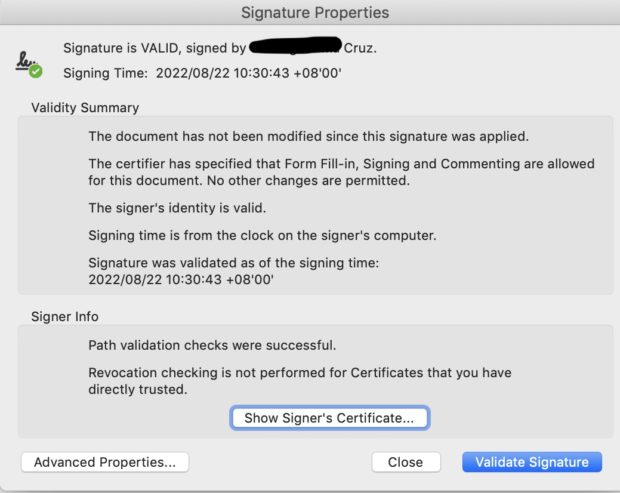Electronic & digital signatures
The E-Commerce Act of 2000 provides recognition for Electronic Documents and Electronic Signatures and states that electronic documents shall have the legal effect, validity, or enforceability as any other document or legal writing. For evidentiary purposes, an electronic document shall be the functional equivalent of a written document. Moreover, an Electronic Signature on an electronic document shall be equivalent to the signature of a person on a written document as long as it can be shown that it was made through a prescribed procedure not alterable by the parties. (Sections 7 & 8, Republic Act No. 8792)
The Supreme Court has decided several cases where it affirmed the validity and legality of electronic documents and signatures such as AES Watch v. Commission on Elections where it was declared that PCOS machines are capable of producing Digital Signatures as the machine algorithm generates keys with a method within which to compare these keys. (G.R. No. 246332, December 9, 2020)
The COVID pandemic has normalized work from home arrangements and our world continues to be ever more connected. Traditional methods of physical or “wet ink” signatures on documents are slowly being replaced by Electronic Signatures and Digital Signatures.
In the Philippines, various Government agencies have also started to adopt policies and procedures to recognize electronic documents and signatures. It is said that 97% of the Office of the Solicitor General’s workforce is already using Digital Signatures provided by Department of Information Communication and Technology’s (DICT) Philippine National Public Key Infrastructure (PNPKI) service. The Securities and Exchange Commission allows companies to execute their Audited Financial Statements using Electronic Signatures and submit them online. The Bureau of Internal Revenue, has also issued Revenue Memorandum 29-2021 which provides for the adoption of Electronic Signatures in certain Forms and Certificates. Cities and Municipalities have also been instructed to recognize the use of Electronic Signatures for the approval of business permits and licenses. Moreover, the Anti-Red Tape Authority has directed government agencies to avail of and recognize the use of Electronic Signatures using the PNPKI.
We must expect, then, that Electronic Documents, Electronic and/or Digital Signatures will continue to play an even more integral part in our daily lives. Notably, it is not uncommon to see that the terms Electronic Signature and Digital Signature being used interchangeably. But these two terms do not mean the same thing and are not identical. While all Digital Signatures are a form of Electronic Signature, not all Electronic Signatures are Digital Signatures.
Electronic Signatures do not necessarily have to be a signature as traditionally understood. It may refer to any distinctive mark, characteristic and/or sound in electronic form, representing the identity of a person and attached to or logically associated with the electronic data message or electronic document or any methodology or procedures employed or adopted by a person and executed or adopted by such person with the intention of authenticating or approving an electronic data message or electronic document. (Section 2[e], Rule 5, E Commerce Act of 2000)
On the other hand, a Digital Signature refers to an electronic signature consisting of a transformation of an electronic document or an electronic data message using an asymmetric or public cryptosystem such that a person having the initial untransformed electronic document and the signer’s public key can accurately determine: (i) whether the transformation was created using the private key that corresponds to the signer’s public key; and (ii) whether the initial electronic document had been altered after the transformation was made. (Section 1, Rule 2, Supreme Court Rules on Electronic Evidence, A.M. No. 01-7-01-SC, 2001)
For a clearer understanding of how an Electronic Signature is different from a Digital Signature, an Electronic Signature will generally look different from that of a Digital Signature. The following is an illustrative example.
Digitally signed documents also allow the recipient to verify the credentials of the document and signature by clicking on the signature itself which will show the following information.

Such information is not available in Electronic Signatures which is why it may be possible to copy or cut and then paste an Electronic Signature onto another document to misrepresent that it had been signed by somebody when in truth the person had not signed the document.
Another important function of a Digital Signature is that after the signature is applied onto a document, the signatory can lock the document to prohibit any other change.
Accordingly, the use of a Digital Signature allows for the confirmation that the document is authentic coming from a verified source, the identity of the signatory has been verified by a publicly trusted organization, and that the document has not been tampered with since being digitally signed.
As to the creation of electronic signatures, these can be created and affixed on a PDF document using software applications such as, but not limited to, the Adobe Acrobat DC by clicking on the “Fill & Sign” button. While the same software application also has an option to create a Digital Signature via the “Certificates” function, it is recommended that those who wish to create their Digital Signature do so via the DICT’s PNPKI service so that their digital signature would carry with it the credentials issued by a trusted and official government organization.
Accordingly, when dealing with sensitive documents such as contracts, agreements, and documents to be submitted to government agencies it is recommended that a Digital Signature be used. On the other hand, for everyday correspondence such as letters, memos and notifications one may simply use an electronic signature.
Now that that transactions are increasingly executed online, we may find ourselves using our electronic or digital signatures more than wet signatures in the not-so-distant future. Therefore, now is a good time to get started in creating one’s own Electronic and Digital signatures.
(The author, Atty. John Philip C. Siao, is a practicing lawyer and the Co-Managing Partner of the Tiongco Siao Bello & Associates Law Offices [TSBLaw]). He may be contacted at jcs@tiongcosiaobellolaw.com. The views expressed in this article belong to the author alone and do not in any way reflect the view or opinion of TSBLaw or any member thereof.)



